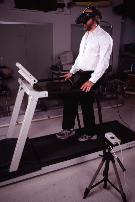Virtual Reality Training for
Fall Prevention
David L. Jaffe, MS at the VA Palo Alto
Health Care System's Rehabilitation Research and Development Center and David
A. Brown, PT, PhD at Northwestern University Medical School's Department of
Physical Therapy in Chicago are spearheading a VA funded project involving
Virtual Reality (VR) technology in preventing falls. As one of three
interventions being investigated in the project, VR is being used to study
stepping-over responses in elderly subjects using simulated objects.
The long-term goal of their work is to
investigate techniques to monitor and improve performance in stepping-over
obstacles and train more effective movement strategies of elderly individuals
at high risk for falling.
Brown and Jaffe's VR lab employs a color
video camera trained on the subject's legs from the side. The computer
generates images of rectangular objects of various heights and lengths. The
combined image of the legs and virtual objects is presented in a head-mounted
display (HMD).
Subjects wear the HMD as they walk on
the treadmill, stepping over the virtual obstacles they see at their feet. The
combined leg/obstacle video is analyzed by the computer for intersections of
the subject's feet with the virtual obstacles. A collision by the toe on the
front edge of the obstacle would indicate that the subject did not lift the
foot high enough, while a collision with the heel on the top of the obstacle
would indicate the subject did not step far enough. As these collisions are
detected, vibro-tactile feedback is applied to the heel or toe of the foot
involved in the collision.
All subjects walking on the treadmill
wear an overhead harness to prevent injury in the case of a loss of balance or
fall.

When stepping over obstacles during
over-ground walking, young, healthy persons step over higher objects by
increasing knee and hip flexion, and when stepping over longer objects they
increase stride length. A pilot study verified this same strategy is employed
when stepping over the computer-generated obstacles displayed during the
treadmill walking.
In a small group of elderly subjects,
the training regimen showed a positive result in that subjects were better able
to negotiate an over-ground obstacle course after three training sessions.
Jaffe and Brown plan to perform a randomized, controlled study to separate out
the nonspecific effects, and have plans to further develop the system so that
it can be used in a wide variety of clinical settings and clinical populations.
Future work on this project may explore
simulation techniques with walking aids such as canes and crutches. Other
potential areas of research include the study of improvements in fitness and
gait through simulation of walking situations for ambulatory nursing home
patients and teaching environmental factors and modifications of avoid falls.
The system could potentially provide an enjoyable and safe environment for
general exercise, a safe setting for "wanderers", or a simulated
practice session for way-finding and familiarization of nursing home patients
with their facility.
For more information about the project,
contact David L. Jaffe, MS, VA Palo Alto Health Care System, Rehabilitation
Research and Development Center; or David A. Brown, PhD, PT, Northwestern
University Medical School, Department of Physcial Therapy;
|